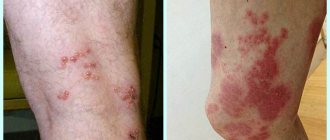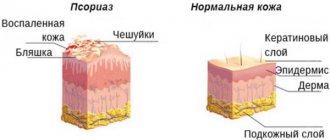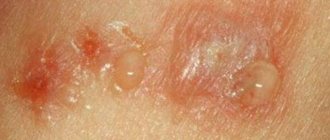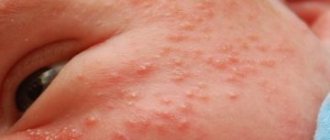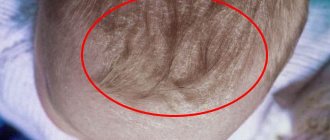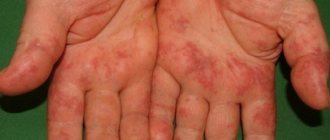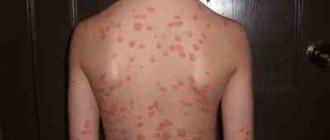Erythema in children is redness of the skin (the appearance of an erythematous rash) caused by various physiological or pathological reasons, including infections, allergic reactions, skin diseases or a banal feeling of shyness. The anomaly can also occur after burns, massage, and physiotherapeutic procedures. The pathology is often confused with rubella, dermatitis, urticaria, and other types of rashes.
Diagnostics
The diagnosis of exudative erythema multiforme in typical cases is not difficult.
However, in the febrile variant, before the appearance of characteristic rashes, one can think about many acute infectious diseases - influenza, typhoid, acute articular rheumatism, etc., and in the initial stage of confluent exudative erythema multiforme - about severe hemorrhagic measles, chicken pox, etc. Erythematous-papular exudative erythema must be differentiated from drug rashes (history, more severe itching, brownish tint, relapses after taking certain medications), urticaria (severe itching, irregularly shaped rashes, more rapid development and ephemerality, lack of a favorite localization), chills (red-violet color) . With tumoral lupus erythematosus, moderate punctate hyperkeratosis, a tendency to atrophy, a different course and a characteristic histological picture are detected. With erythema nodosum, the initial element is a node; their number is small, they are characterized by localization on the anterior surface of the legs and a change in color during the process of resolution. Sometimes exudative erythema multiforme may resemble indurated erythema of Bazin, annular Darier, or chronic migratory Afzelius-Lipschütz.
The erythematous-vesico-bullous form must be distinguished from Dühring's dermatitis herpetiformis (characteristic location of more profuse rashes causing burning or pain, absence of fever and general symptoms, eosinophilia in the contents of vesicles and blisters, predominant localization on the trunk, slower development, increased sensitivity to iodide potassium), ordinary chronic pemphigus (large blisters, develop slowly, usually on apparently healthy skin, Nikolsky's symptom is positive, the general condition is severe, acantholytic cells are in the smears), severe dermatosis (rapid course with a fatal outcome), erythematous pemphigus (Senir syndrome -Ascher, long-term course with exacerbations, positive Nikolsky sign, acantholytic cells), bullous toxicderma (history, relapses, itching or burning, accompanying purpuras, test results).
Erotic syphilitic papules on the mucous membranes are painless, darker in color, do not have a fringe of exfoliating epithelium, a bright inflammatory rim and are less prone to peripheral growth. They are accompanied by polyscleradenitis, positive serological reactions, and other manifestations of secondary syphilis. In the discharge you can find pale treponema. With foot and mouth disease there is diffuse stomatitis, often affecting the anogenital area, facial skin, limbs and around the nails, and gastrointestinal disorders. With various types of aphthosis, erosions are smaller in size, but deeper, rounded, and not prone to merging. They do not bleed and are not preceded by blistering.
Erythematous spots
Maculopapular and erythematous photo rash can also appear in the form of infiltrated papules, affecting in most cases various areas of the skin of the neck and face. Much less often, these manifestations can affect the skin of the body. As a rule, the medical prognosis is always positive and these neoplasms are benign.
The main cause of the development of maculopapular erythema is the toxic effects of streptococcal or staphylococcal infections in the human body. In addition, the reasons may lie in improper, unhealthy diet.
With proper treatment of papular neoplasms, there will be no visible signs of the disease on the skin. During treatment, itching and peeling of the epidermis on the affected areas of the skin may occur.
If you find such tumors on your body, you should immediately seek professional help from a specialist. The therapeutic course should be prescribed exclusively by the attending physician based on a detailed examination. Its effectiveness and recovery time depend on this.
It is extremely important to understand that the advanced form of erythema requires very long and difficult treatment in a hospital. It can leave a detrimental mark on the condition of the entire body as a whole.
Therefore, if you detect any manifestations of the symptoms listed in this article, you should call a doctor at home as soon as possible. Self-medication can only cause harm, aggravate the current condition, and also complicate diagnosis.
We looked at the erythematous rash photo with explanations. Have you ever seen a rash like this? Leave your opinion or feedback for everyone on the forum
Erythema in children and adults, photos with explanations
Erythema is redness of the epidermis. This reaction of the skin can be caused by an increase or decrease in air temperature, contact of the body with hot water and other similar factors. In this case, redness of the epidermis is not a cause for concern.
If the condition occurs for no apparent reason, it is recommended to seek medical help, since it may be a symptom of a disease that threatens not only the health, but also the life of a person.
Erythema: what is it?
Skin erythema is redness of the epidermis, which occurs due to dilation of capillaries. Such vessels are located directly in the skin. For this reason, a sharp flow of blood into them affects the change in skin tone.
The prerequisites for such manifestations are most often ordinary physiological processes, but it can also be associated with pathologies.
Erythema has such types as physiological and pathological disease. Each of them has its own reasons for its occurrence.
Physiological skin erythema quickly passes and is not a consequence of the development of pathologies. Here are the reasons for this type of redness:
- reaction to changes in the emotional background - shame, indignation and others;
- vegetative-vascular disorders that occur for natural reasons, for example, during menopause or during pregnancy;
- physical impact - blow, rubbing and others;
- change in air temperature - heat or frost;
- use of medications that cause vasodilation;
- contact with the epidermis of any substances that irritate the skin - household chemicals, various ointments and other products.
This type of redness, pathological erythema, occurs due to any disease. Here are the causes of this disease:
- general pathologies caused by infections;
- chronic skin diseases - chronic erythema;
- diseases of the epidermis of non-infectious and infectious nature;
- autoimmune pathologies;
- allergies, especially to medications;
- somatic pathologies;
- physiotherapy;
- a reaction of the epidermis to ultraviolet radiation, which is called solar erythema.
The occurrence of redness often occurs due to several reasons. To cure a disease, it is necessary to get rid of the factor that caused it.
Erythema nodosum
The symptomatology of this form of pathology is the presence of red spots on the surface of the skin. They have a dense structure, and their presence on the epidermis causes discomfort in the patient. You can learn more about erythema nodosum here.
The characteristic manifestations of the disease are that the spots appear suddenly and also disappear unexpectedly. They can go away quickly or within a few days after their appearance.
In the nodular form, the inflammatory process occurs in the thickness of the epidermis and in the fatty tissue. The diameter of the rash ranges from one to ten centimeters. Locations: inner thigh and lower leg. Facial erythema in this case is extremely rare.
The manifestation of pathology is influenced by viruses that penetrate the body. In this case, the following manifestations are added to the underlying symptoms: pain in the joints, increased body temperature, inflammation of the mucous membrane of the organs of vision and general malaise.
Viral erythema
Erythema in a child develops due to the penetration of viruses into the body. Children aged 2 to 4 years are susceptible to pathology. Most often, the disease due to viruses appears in the spring or autumn. Characteristic symptoms of the pathology:
- sore throat;
- temperature increase;
- itching in the nose;
- pain in the head area;
- rhinitis;
- the appearance of rashes on the epidermis and in the oral cavity several days after viruses enter the body.
Nature of the disease and forms of manifestation
Children aged 4 to 12 years are most susceptible to infection. The disease is classified as a respiratory infection; the causative agent is often not identified, but most claim that it is the B19 virus from the group of paraviruses, which has several routes of transmission:
- airborne is the main route of infection; local outbreaks are often observed in children's groups or families,
- transplacental, infection of a newborn from a sick mother,
- the parenteral route (infection through donor blood transfusion) is rare.
The incubation (latent) period lasts 7–14 days, and successful completion of the disease forms lifelong immunity.
There are several clinical forms of the disease, differing in duration and severity:
- erythema of Chamera,
- Rosenberg's erythema,
- exudative erythema,
- knotty,
- sudden erythema,
- atypical, occurring as arthralgia or liver damage,
- asymptomatic with signs of a common respiratory infection.
Blood transfusion, one of the ways of transmitting erythema
Classification of pathology
Depending on the cause of its occurrence, erythema has a certain character:
- infectious (pathological) – provoked by nonspecific pathogens that have entered the surface of the epidermis, mucous membranes, and into the systemic bloodstream;
- non-infectious - caused by physiological reactions of the body in response to internal or external stimuli.
The infectious type of reaction occurs in acute and chronic forms. Usually the inflammatory process begins with a pronounced clinical picture. If left untreated, the symptoms fade away, and the pathology becomes chronic with periodic exacerbations.
Depending on what symptoms the erythema has and the appropriate treatment is chosen. The clinical picture of the reaction depends on its causative agent. With a skin rash, the patient experiences itching, discomfort, and pain. Some forms of the inflammatory process occur with an increase in body temperature to critical levels, dyspeptic disorders, weakness and a general deterioration in well-being. Inclusions may have a smoothed surface, papules and macules, and watery pimples.
Non-infectious
The human body has protective reactions. In response to the stimulus, the immune system is activated with characteristic manifestations. Non-infectious forms of skin reactions are classified according to the causes of their occurrence.
- Infrared - develops due to prolonged contact with infrared rays, the strength of which does not allow the epidermis to receive a full-fledged burn. It is characterized by the appearance of reddish spots in the form of a mesh on the surface of the epidermis.
- X-ray – formed when exposed to X-rays or electromagnetic waves. Accompanied by the formation of inclusions with clear boundaries.
- Symptomatic (fixing) – occurs upon contact with an allergen, often after eating certain foods and medications. A characteristic sign of fixed erythema is hyperemia of the skin in the form of a spot with uneven edges and bulges.
- Idiopathic (hereditary) - is formed when the lumen of the capillaries in the places adjacent to the common vascular network increases. It is accompanied by redness on the surface of the palms and in some cases spreads to the feet.
- Cold - occurs during prolonged contact of the skin with low temperatures. A reddish-bluish rash on the skin is accompanied by local swelling and itching.
- Ultraviolet - caused by the skin's reaction to exposure to ultraviolet rays. It has a complex of symptoms of varying intensity - from local hyperemia to the formation of blisters with damage to deep layers.
Physiological skin reactions have pronounced, rapidly increasing symptoms, and treatment must be started immediately. The main point in the treatment of the inflammatory process is to limit contact with the irritant. A physiological rash can occur as a result of prolonged friction of the epidermis (for example, during massage) or due to psycho-emotional arousal. There are cases when skin hyperemia appeared during orgasm and hypnosis.
Treatment of non-infectious rash involves providing symptomatic care. The patient is prescribed antipruritic antihistamines, antispasmodics, painkillers and medications that accelerate tissue regeneration.
There is a hypothesis that physiological erythema has psychosomatic causes.
Infectious (pathological)
Erythema is pathological in nature when caused by infectious agents: viruses, fungi, bacteria, parasites. This form is acute, but can become chronic. It is more difficult to cure the latter, therefore, if the disease is pathological, a person requires immediate medical attention.
Erythema infectiosum is classified according to the causes and symptoms of the disease. Each form has individual treatment.
Histopathology
A needle biopsy can be used to confirm the diagnosis of ME. The classic lesion reveals vacuolar interface dermatitis with prominent lymphocyte infiltration along the dermoepidermal junction. In addition, dyskeratosis of basal keratinocytes and hydropic changes may be observed. In advanced lesions, epidermal necrosis, subepidermal blisters and vesicles are usually observed. CD 8 T lymphocytes and macrophages predominate.
Kinds
Pathology amazes with the variety of types - there are 28 of them:
- Persistent towering. Another name is persistent erythema. A rare disease with an unspecified etiology. Oblong ridges of rich red color are formed.
- Dychromic. One of the varieties of red lichen. The spots are ash-blue. No treatment has been developed.
- Stevens-Johnson. A variety of multiform. Characterized by general intoxication.
- Viral. It begins as an acute viral disease, but is distinguished by a small rash resembling diathesis. It appears in the initial stage on the cheeks, then on the internal organs. Children of primary preschool age are most often affected. The danger lies in damage to the functions of hematopoiesis, joints and bone marrow.
- Infectious. It is caused by parvovirus, and the main risk group is preschool children. The rash covers the cheeks, then the entire body. It is often asymptomatic.
- Symptomatic. They cause emotions - anger, shame, excitement.
- Chamera. The etiology of the disease is infectious. The rash has the appearance of a butterfly, the rash merges into large spots. It is not difficult to tolerate and is accompanied by symptoms of mild intoxication.
- Polymorphic. One of the types of erythema multiforme. The rash occurs in the form of spots, hemorrhagic effusions, nodules and blisters filled with liquid.
- Physiological. Appears when there is a difference in temperature or under the influence of natural irritants. It is observed in infants in the postpartum period. It goes away on its own.
- Centrifugal erythema of Biette. Refers to a type of lupus erythematosus.
- Centrifugal erythema of Daria. Rash in the form of rings with unknown etiology.
- Ring-shaped. Occurs with weak immunity, cancer, fungal and bacterial infections. The body is covered with huge spots in the form of rings.
- Toxic form of newborns. It is of allergic origin. Treated with antihistamines.
- Exudative multiform - has a toxic-allergic nature. Sore throat, headache, muscles. The rash grows up to 3 centimeters, the spots merge into large “continents” and have a bluish tint. They appear symmetrically on the body and frame the lips on the face. Pain and itching are felt.
- Radial. Appears as a reaction to an x-ray examination.
- Scarlatiniform. The causative agents are streptococci and staphylococci. The prognosis is favorable.
- Nodular - the course of the disease can be acute or chronic. The rash looks like nodules that are painful to the touch. The diameter of the papules varies from ½ to 5 centimeters. There are practically no rashes on the face.
- Solar. Appears during prolonged exposure to the open sun, sometimes it is of an allergic nature. Hyperthermia is accompanied by swelling and deterioration of well-being.
- Miliana. Appears as a result of an allergy to the anti-syphilis drug salvarsan.
- Cold. Occurs as a reaction to cold. There is no specific therapy.
- Twisty Gammel. Resembles a cut of a tree, found in cancer.
- Bordered. Autoimmune response to the administration of medicinal serums. Manifested by urticaria.
- Afzelius-Lipschütz. Borreliosis or Lyme disease. The causative agent of the disease is a tick. Antibacterial and symptomatic therapy is carried out.
- Telangiectatic Bloom. The second name is infrared. Occurs with prolonged exposure to infrared radiation - a fireplace, heating pad.
- Palmarnaya. Popularly called “liver palms”. Hyperemia is noted over the entire area of the palms. Cause abnormal liver and blood diseases, rheumatoid arthritis.
- Vascular erythema.
- Nodose. Synonym for knotty. Creeping.
Depending on the factors of occurrence, infectious and non-infectious hyperthermia are distinguished.
Infectious diseases include:
- exanthema;
- Lyme disease;
- multiform;
- undifferentiated;
- migratory;
- nodal
Non-infectious forms cause autoimmune reactions of the body to external stimuli.
Non-infectious forms:
- x-ray (radiation);
- persistent;
- infrared.
Signs
It manifests itself in different ways and depends on the type of disease.
Caused by infection, it is accompanied by fever, aches and swelling of the joints. The onset is acute, with severe headache, weakness, and chills.
Exudative erythema is the most dangerous and can lead to death. It begins with general symptoms of illness - aches and pain in muscles and joints, headache and sore throat. The rash covers the skin of the forearms, palms, palms and soles, mucous membranes of the oral cavity and nasopharynx. In addition to spots, the skin is covered with papules with serous contents. They burst and form open bleeding ulcers.
Lyme disease is viral in origin. The carriers are ticks. Persistent redness appears at the site of the bite, which increases in size. Accompanied by tissue compaction at the site of suction, and symptoms of damage to the central nervous system and musculoskeletal system.
One type of erythema is exanthema. It begins acutely, with an increase in body temperature, accompanied by headache and emotional agitation. After a few days, the headache subsides, and a pink, erythematous rash covers the body. After recovery, the skin returns to its original appearance.
Erythema multiforme exudative
The disease begins suddenly with fever, general malaise and headache. A rash in the form of red spots appears on the limbs, face, genitals and often on the mucous membrane of the mouth, the spots are symmetrically located and slightly raised above the surface of the skin.
The central part becomes bluish-red, while the rest remains bright red and rises to the center. The rash may appear in bumps up to 1 cm in size. Crusted blisters may appear, then ulcers form in their place. The duration of the disease is 10–15 days and then, as a rule, everything resolves safely. Relapses are possible with repeated use of medications that cause the disease.
But there is a severe manifestation of the pathology - this is Stevens-Johnson syndrome, which occurs as an acute infectious disease: large temperature changes for 2-3 weeks, affecting the skin, internal organs, mucous membrane of the mouth and eyes.
In addition to the usual rashes, large blisters appear on the skin; in the mouth - painful and bleeding ulcers. Erythema can be complicated by inflammation of the cornea, pneumonia, meningitis, etc. There is a possibility of death.
Causes
It is not completely clear, but there are 2 options for the origin of erythema multiforme exudative:
- infectious-allergic (or viral) origin. At the same time, most patients are diagnosed with a chronic infection and periods of exacerbation of the disease occur mainly in early spring and late autumn - during the cold and damp period of the year.
- oxy-allergic origin, mainly to drugs. This form of the disease is essentially no different from drug toxicoderma.
Treatment
Initially, patients are examined to identify possible chronic infections. Depending on the origin of the erythema, the following are prescribed: broad-spectrum antibiotics (but for toxic-allergic causes of the disease, antibiotics are not prescribed), antihistamines, anti-inflammatory drugs. In severe cases, hormonal drugs (prednisolone).
For Stevens-Johnson syndrome, large doses of prednisolone are prescribed, as well as agents for removing toxins (hemodez, polyglucin). Anti-inflammatory, antibacterial, hormonal ointments (Gyoksizon) are used externally.
In case of rashes in the form of bubbles, they are opened and lubricated with a solution of pyoctanin or Fukortsin. If the oral mucosa is damaged, disinfectant and astringent rinses are prescribed; food should be liquid and not irritate the mucous membrane. In cases of eye damage, eye drops are used. Patients with erythema multiforme should avoid hypothermia and maintain bed rest
Treatment
The disease is acute and can cause relapses. In acute cases, symptomatic treatment is necessary.
Relapses that occur must first be stopped and then treated.
To relieve relapses of allergic erythema, a glucocorticosteroid drug is used - diprosan , which has anti-inflammatory, antiallergic and immunosuppressive effects. It is administered intramuscularly and within 24 hours the medicine will be eliminated from the body.
The next stage in treatment is removing the allergen from the body and weakening its effect . Drinking plenty of fluids, sorbents and diuretics are prescribed for this purpose.
Taking antihistamines such as suprastin, tavegil and zodak reduce the severity of local reactions by reducing the antiallergic effect, vascular permeability, capillaries and inhibits exudation and the formation of edema. The drugs are taken in tablets.
Local application is aimed at relieving the inflammatory process and accelerating healing.
- Applications with antibacterial proteolytic enzymes/
- Lubrication with ointments containing antibiotics and corticosteroids, which helps prevent the development of secondary infections/
- Rinsing with antiseptics, a decoction of medicinal herbs for the oral mucosa and baths for the genitals.
Before using any medications, be sure to consult your doctor.
General clinical picture
Most often, a squamous rash of the same type accompanies completely different disorders that occur inside the human body. The term erythema includes some physiological and most pathological conditions of the skin and mucous membranes. They are caused by the expansion of skin capillaries and can appear single or multiple, often merging with each other as pink or red spots of various sizes. Depending on the main cause of the development of the disease, spots are distinguished between physiological and those arising due to pathological conditions.
For example, physiological erythema is distinguished by its short duration, without being considered a consequence of general or local disorders in the human body. Physiological erotema can occur:
- As a result of temperature or physical effects.
- As a reflex reaction during the expression of psycho-emotional instability, for example, joy, excitement, shame, as well as in functional vegetative-vascular disorders, including menopause.
- If any irritating substances come into contact with the skin, for example, alcohol solutions, warming ointments and creams, as well as when taking medications with a vasodilator effect: antihypertensive drugs, nicotinic acid and others.
Pathological erythema is caused by a number of other reasons. The main causes of this type of disease will be as follows:
- Non-infectious and infectious diseases of the skin: dermatoses and dermatitis.
- Infectious diseases of a general nature.
- Autoimmune connective tissue diseases and allergic reactions, in particular to certain medications: non-steroidal anti-inflammatory drugs, penicillin antibiotics and sulfonamides, anticonvulsants, antidepressants, combined oral contraceptives.
- Somatic pathology, for example, circulatory disorders, pulmonary sarcoidosis, Crohn's disease, and pregnancy.
- Physiotherapeutic thermal procedures, solar irradiation, other electrical procedures.
Erythema of the skin and mucous membranes is most often diagnosed in genetically predisposed young patients, whose age ranges from 20 to 30 years, regardless of gender. The disease mainly occurs in those people who are exposed to excessive sun exposure. The disease can be multifactorial in nature, that is, it can be provoked not by one of the factors, but by several at once.
What it is
Erythema is a pronounced vascular reaction on the skin caused by a strong rush of blood to its surface.
This phenomenon can be physiological (natural), for example, appear on the face during severe emotional stress in adults or during prolonged crying in a child.
Erythema can also be a consequence of sunburn, trauma and scratching of the skin, or insect bites. Usually in such cases it does not require treatment. As soon as the provoking factor is eliminated, the redness on the body disappears.
Pathological erythema is caused by toxic effects on the body, endocrine disorders, bacterial, viral or fungal infections. Their symptoms and treatment vary depending on the type of disease.
The manifestations of erythema are very diverse, they vary from slight redness to the formation of large lesions, with thickening of the epidermis, nodular changes in peripheral vessels, profuse rash in the form of papules, pustules, plaques, roseola, blisters, etc.
Pathophysiology
Erythema multiforme is often associated with viral or bacterial infections, especially herpes simplex virus (HSV/HLA). Studies have demonstrated the presence of HSV DNA by polymerase chain reaction in acute or secondary ME lesions. Predisposing factors are unknown. HLA-DQ3 has been reported to be associated with postherpetic ME and has been proposed as an additional diagnostic marker. Other groups of human leukocyte antigens have also been reported as markers of recurrent erythema multiforme.
Causes of the disease
Redness often occurs as a result of intense friction of the skin and exposure to sunlight. Another reason is chemical burns. Erythema may also appear after physical therapy using electric current. Often the cause of the disease is allergies, various types of dermatitis, impaired blood supply to the skin, and infectious diseases.
Depending on the form in which erythema manifests itself, the reasons for the development of this condition may be as follows.
- Erythema migrans in most cases manifests itself after tick bites.
- Ring-shaped is provoked by poisoning and intoxication of the body. Sometimes the cause of this disease is an allergy, an infectious disease, or a malignant tumor.
- Erythema nodosum can be caused by allergic reactions of the body, general intoxication, to which sometimes a virus is added. In this case, the patient’s well-being deteriorates significantly.
- The cause of solar erythema is too intense or prolonged exposure to ultraviolet rays on the skin.
- Viral erythema is the result of penetration of bacteria, viruses, and pathogenic microflora into the epithelium or deeper layers.
- Exudative eczema is provoked by staphylococci and streptococci. The cause of its appearance may be the herpes virus.
- After taking certain categories of medications, a fixed form of the disease may appear.
- Palmar erythema usually develops against the background of liver failure, rheumatoid arthritis, and diseases of the circulatory system. Sometimes it is caused by pregnancy. It may be congenital - in this case it does not require treatment.
- The reasons for the appearance of persistent erythema are not precisely known; presumably, this is one of the manifestations of allergies or a subtype of granuloma.
Possible complications
Erythema infectiosum in children, when its course is uncomplicated, disappears without a trace in 2–3 weeks, forming lifelong immunity.
With immunodeficiency, disturbances in the hematopoietic system are possible. It should be noted that the virus suppresses the production of red blood cells, negatively affecting the bone marrow. In people with a healthy immune system, restoration of hematopoiesis occurs quickly and does not affect the body as a whole. With existing diseases in the blood system, anemia quickly develops, threatening even more serious complications.
Already existing problems with rheumatic joints lead to complications and aggravation of the disease in a child.
Infection due to tuberculosis is difficult to tolerate, since this disease weakens the body's defenses.
Uncontrolled use of sulfonamide drugs and antibiotics has a negative effect on the immune system.
The most serious consequences are caused by infection with erythema infectiosum during pregnancy. The second trimester is the most dangerous; during this period there is a high risk of fetal death and spontaneous miscarriage. Many experts attribute viral erythema to the so-called TORCH - infections, which include rubella, herpes, toxoplasmosis, cytomegalovirus, which is why erythema received its second name - fifth disease. The listed infections have virtually no negative impact on the pregnant woman herself, but have a detrimental effect on the fetus.
Viral erythema, one of the most dangerous diseases for pregnant women

